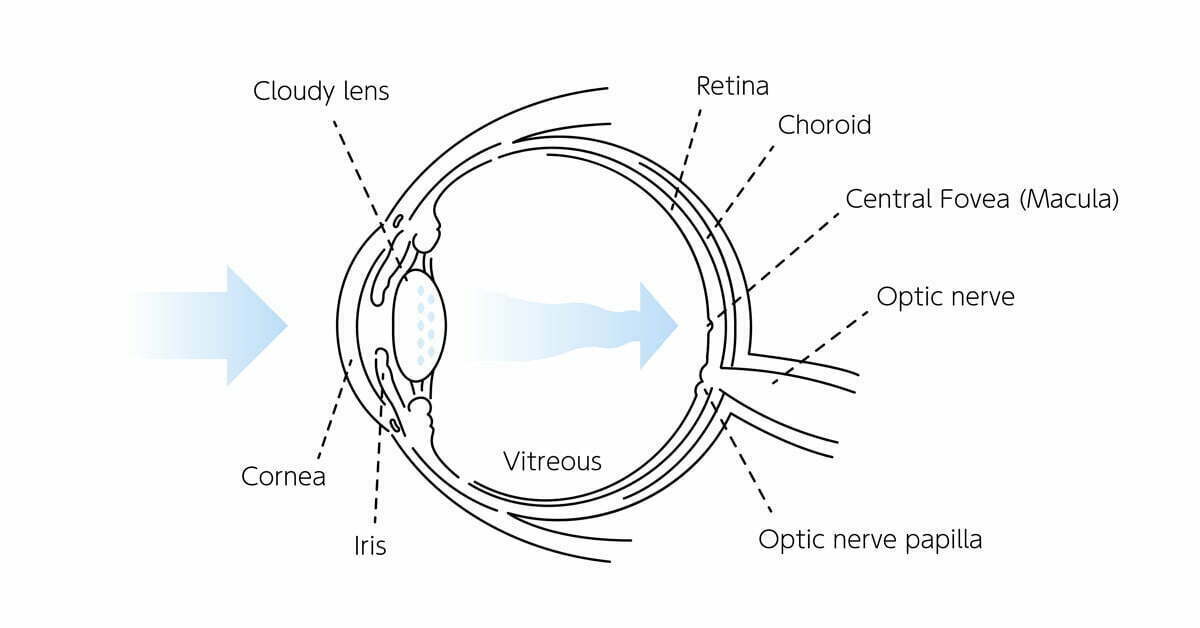
If you notice your vision is cloudy, making it difficult to read, drive a vehicle at night, or see someone’s facial features when they’re standing directly in front of you, you might have cataracts. In fact, according to the Kellogg Eye Center at the University of Michigan, more than 90% of people have cataracts by the age of 65, and half of the population between ages 75 and 85 have lost some vision due to a cataract. Luckily, you don’t have to live with cataracts.
Can you have cataracts and not know it?
Cataracts form when protein builds up in the lens in your eye and eventually clouds your vision. Most cataracts develop slowly and don’t impair your vision, so yes, you might not even know you have cataracts. Over time, as your vision gets increasingly cloudy, you might realize something’s wrong.
Cataracts typically come in one of three forms:
- Nuclear: Also referred to as a nuclear sclerotic cataract, this type of cataract is the most common. It forms at the center of the lens, which is known as the nucleus. Over time, the lens hardens and turns yellow or brown. You might have difficulty viewing small details, and you see halos around bright lights, particularly at night.
- Cortical: This type of cataract mimics the outside shape of your lens, which is called the cortex. It starts as a white wedge that resembles a triangle pointing toward the eye’s center. As it grows, the cataract scatters the light. The major symptom of this cataract is glare, and you might have difficulty driving at night.
- Posterior subcapsular: This type of cataract forms at the back of your lens capsule, which is the part that surrounds the lens and keeps it in place. It affects your close-up vision and makes it difficult to see in bright light.
Other, less common types of cataracts include anterior subcapsular (it forms at the front of your lens capsule), congenital (it forms when you’re born or as a child), traumatic (it forms due to an injury), radiation (it forms due to too much sun exposure), and lamellar (it forms in younger children in both eyes).
An eye care professional can perform a dilated eye exam to determine if you have cataracts. You might also get your vision checked while in different lighting conditions, and you might receive an updated glasses prescription. You must have a complete eye exam to rule out any other factors that might be causing your symptoms.
7 Symptoms of Cataracts

“Cataract Symptoms” licensed under CC BY 2.0 via Flickr by hahn.elizabeth34
Cataracts aren’t caused by overuse of your eyes, and they don’t travel from one eye to the other. They develop slowly, so you might not notice them until they block light from your vision. If you think you might have cataracts, take stock in seven of the more common cataract symptoms:
- A decrease in clarity of your vision that you cannot correct with glasses.
- Sensitivity to light, including seeing halos around lights.
- Double-vision in one eye.
- Changes in the way you see colors.
- Increased difficulty seeing at night, such as having a glare from oncoming headlights.
- Need for brighter lights for reading or other activities.
- Nearsightedness, if you’re older.
At what stage should cataracts be removed?
Although you can’t prevent cataracts from forming, you can slow their progression by protecting your eyes from ultraviolet light. Smoking can also increase the rate of formation, so you might reduce your risk by avoiding or quitting smoking.
However, once cataracts form, the only way to get rid of them completely is to have them surgically removed and the lens replaced with an artificial one. You might not need cataract surgery right away; instead, you might manage for some time with a stronger prescription for your glasses. Medication will not work. Surgery is usually performed on an outpatient basis under local anesthesia. The entire procedure takes about 15 to 20 minutes. If you have cataracts in both eyes, your first eye must heal before you can have the second eye repaired.
The ophthalmologist can implant different types and powers of lenses to help your vision, including ones that can correct astigmatism. Your surgeon can discuss with you what implant lens type and power are appropriate for your situation. During the procedure, the ophthalmologist makes a small incision in your eye to remove the clouded natural lens and replaces it with an artificial intraocular lens (IOL). Common types of IOLs include:
- Crystalens: This option gives you sharp and clear vision from a distance. The muscles that control the shape of your eye’s natural lens help your new IOL focus.
- ReSTOR: This option also gives you clear vision at all distances, but it works differently than the Crystalens. The lens has a series of concentric steps built in, and they all work differently with light to help it focus.
- Tecnis IOL: This option gives you clear vision at many distances and improves night vision. It also can improve your contrast sensitivity in low-light conditions.
- Toric IOL: This option is ideal if you’re dealing with astigmatism.
You’ll need to rest for a couple of days after the surgery and apply eye drops for several weeks to promote proper healing. Within a few days after the procedure, you might notice an improvement in your vision. Depending on the IOL your surgeon used, you might find you don’t need to wear glasses as often, but you will still need them for reading if you used them prior. In some cases, patients regain 20/20 vision post-surgery.
If you have further questions about cataracts or are interested in having customized cataract surgery, reach out to Northeastern Eye Institute (NEI). As the largest and most comprehensive eye care center in Pennsylvania, we use cutting-edge eye care technology to give our patients the best treatment options available. In fact, two of our doctors, Dr. Jerome Jordan and Dr. William Jordan, were the first to perform IOL implant surgery to treat cataracts. Contact us today, and let us help you see the world better.